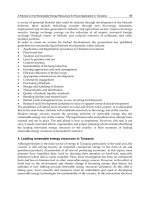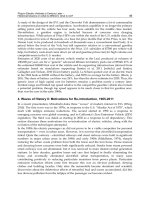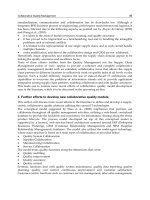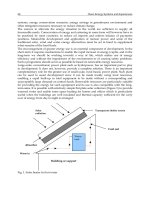Chapter 039. Nausea, Vomiting, and Indigestion (Part 4) pdf
Bạn đang xem bản rút gọn của tài liệu. Xem và tải ngay bản đầy đủ của tài liệu tại đây (18.33 KB, 7 trang )
Chapter 039. Nausea, Vomiting,
and Indigestion
(Part 4)
Diagnostic Testing
For intractable symptoms or an elusive diagnosis, selected diagnostic tests
can direct clinical management. Electrolyte replenishment is indicated for
hypokalemia or metabolic alkalosis. Detection of iron-deficiency anemia mandates
a search for mucosal injury. Pancreaticobiliary disease is indicated by abnormal
pancreatic enzymes or liver biochemistries, whereas endocrinologic,
rheumatologic, or paraneoplastic etiologies are suggested by specific hormone or
serologic testing. If luminal obstruction is suspected, supine and upright
abdominal radiographs may show intestinal air-fluid levels with reduced colonic
air. Ileus is characterized by diffusely dilated air-filled bowel loops.
Anatomic studies may be indicated if initial testing is nondiagnostic. Upper
endoscopy detects ulcers or malignancy, while small-bowel barium radiography
diagnoses partial small-bowel obstruction. Colonoscopy or contrast enema
radiography can detect colonic obstruction. Abdominal ultrasound or computed
tomography (CT) defines intraperitoneal inflammatory processes, while CT or
magnetic resonance imaging (MRI) of the head can delineate intracranial disease.
Mesenteric angiography or MRI is useful when ischemia is considered.
Gastrointestinal motility testing may detect a motor disorder that
contributes to symptoms when anatomic abnormalities are absent. Gastroparesis
commonly is diagnosed using gastric scintigraphy, by which emptying of a
radiolabeled meal is measured. Isotopic breath tests and telemetry capsule
methods also have been validated. Electrogastrography, a noninvasive test of
gastric slow-wave activity using cutaneous electrodes placed over the stomach,
has been proposed as an alternate means of diagnosing gastroparesis. The
diagnosis of intestinal pseudoobstruction often is suggested by abnormal barium
transit and luminal dilation on small-bowel contrast radiography. Small-intestinal
manometry can confirm the diagnosis and further characterize the motor
abnormality as neuropathic or myopathic based on contractile patterns. Such
investigation can obviate the need for open intestinal biopsy to evaluate for
smooth muscle or neuronal degeneration.
Nausea and Vomiting: Treatment
General Principles
Therapy of vomiting is tailored to correction of medically or surgically
remediable abnormalities if possible. Hospitalization is considered for severe
dehydration especially if oral fluid replenishment cannot be sustained. Once oral
intake is tolerated, nutrients are restarted with liquids that are low in fat, as lipids
delay gastric emptying. Foods high in indigestible residues are avoided as these
also prolong gastric retention.
Antiemetic Medications
The most commonly used antiemetic agents act on sites within the central
nervous system (Table 39-2). Antihistamines such as meclizine and
dimenhydrinate and anticholinergic drugs like scopolamine act on labyrinthine-
activated pathways and are useful in motion sickness and inner ear disorders.
Dopamine D
2
antagonists treat emesis evoked by area postrema stimuli and are
useful for medication, toxic, and metabolic etiologies. Dopamine antagonists
freely cross the blood-brain barrier and cause anxiety, dystonic reactions,
hyperprolactinemic effects (galactorrhea and sexual dysfunction), and irreversible
tardive dyskinesia.
Table 39-2 Treatment of Nausea and Vomiting
Treatm
ent
Mechanism Examples Clinical
Indications
Antieme
tic agents
Antihistamine
rgic
Dimenhydrinate,
meclizine
Motion
sickness, inner ear
disease
Anticholinergi
c
Scopolamine Motion
sickness, inner ear
disease
Antidopamine
rgic
Prochlorperazine,
thiethylperazine
Medication-
,
toxin-
, or
metabolic-induced
emesis
5-HT
3
antagonist
Ondansetron,
granisetron
Chemothera
py- and radiation-
induced emesis,
postoperative
emesis
NK
1
antagonist
Aprepitant Chemothera
py-
induced nausea
and vomiting
Tricyclic
antidepressant
Amitriptyline,
nortriptyline
Chronic
idiopathic nausea,
functional
vomiting, cyclic
vomiting syndrome
Prokinet
ic agents
5-HT
4
agonist
and
antidopaminergic
Metoclopramide Gastroparesi
s
Motilin
agonist
Erythromycin Gastroparesi
s, ?intestinal
pseudoobstruction
Peripheral
antidopaminergic
Domperidone Gastroparesi
s
5-HT
4
agonist
Tegaserod ?Gastropares
is, ?intestinal
pseudoobstruction
Somatostatin
analogue
Octreotide Intestinal
pseudoobstruction
Special
settings
Benzodiazepi
nes
Lorazepam Anticipatory
nausea and
vomiting with
chemotherapy
Glucocorticoi
ds
Methylprednisolo
ne, dexamethasone
Chemothera
py-induced emesis
Cannabinoids
Tetrahydrocanna
binol
?Chemother
apy-induced emesis
Other drug classes exhibit antiemetic properties. Serotonin 5-HT
3
antagonists such as ondansetron and granisetron exhibit utility in postoperative
vomiting, after radiation therapy, and in the prevention of cancer chemotherapy–
induced emesis. The usefulness of 5-HT
3
antagonists for other causes of emesis is
less well established. Low-dose tricyclic antidepressant agents provide
symptomatic benefit in patients with chronic idiopathic nausea and functional
vomiting as well as in diabetic patients with nausea and vomiting whose disease is
of long standing.









